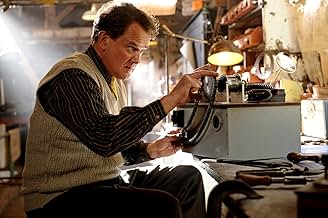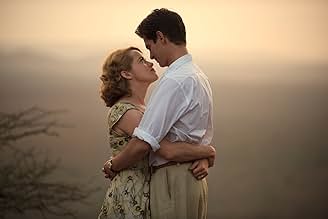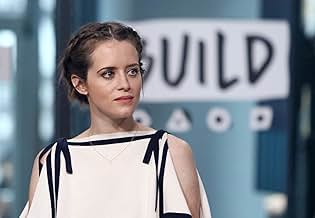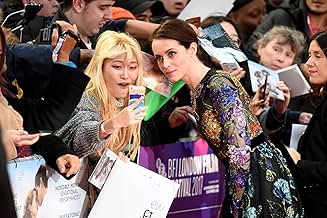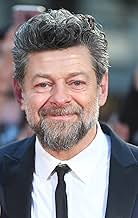La vera e motivante storia d'amore di Robin e Diana Cavendish, una coppia avventurosa che si rifiuta di perdere le speranze di fronte a una malattia devastante. La loro edificante celebrazio... Leggi tuttoLa vera e motivante storia d'amore di Robin e Diana Cavendish, una coppia avventurosa che si rifiuta di perdere le speranze di fronte a una malattia devastante. La loro edificante celebrazione delle possibilità umane segna il debutto del regista Andy Serkis.La vera e motivante storia d'amore di Robin e Diana Cavendish, una coppia avventurosa che si rifiuta di perdere le speranze di fronte a una malattia devastante. La loro edificante celebrazione delle possibilità umane segna il debutto del regista Andy Serkis.
- Regia
- Sceneggiatura
- Star
- Premi
- 1 vittoria e 5 candidature totali
- Colin Campbell
- (as Edward Speleers)
Recensioni in evidenza
Set in the 1950s, Robin Cavendish (Andrew Garfield), a dashing young tea-broker, met the love of his life Diana (Claire Foy) at a cricket game. Before long, they are courting, married, and set for an idyllic yet modest life together until Robin is struck down by the paralysis of polio. At the time, the only prognosis was a short life tied to a hospital respirator. For the active Robin death was preferable to being tethered to an artificial lung, but Diana would have none of it. Close friend and inventor Teddy Hall (Hugh Bonneville) pioneered a wheel-chair with a battery powered respirator that freed Robin from a life inside hospital, despite advice that he would not survive outside for more than two weeks. The story traces their adventurous lives together, including a trip to Africa and a disability conference in Germany. Perhaps the film's most disturbing image is a German hospital where polio victims are laid out in morgue-like boxes, kept alive only by mechanical respirators.
It is impossible to imagine this film being bearable without Andrew Garfield's extraordinary performance, supported by Claire Foy in the equally demanding role of his wife. Garfield possesses one of cinema's most expressive faces which he deploys to full effect as the mostly prostrated polio patient who can only speak a short sentence at a time between breaths. From the depths of wanting to die to the joyful heights of feeling his baby son's skin against his face, Garfield communicates in a facial sign language that says more than the words of fine orators. Some viewers will fairly believe that Claire Foy is the film's real star. Where Garfield is an emotional roller coaster, Foy is a powerhouse of defiant strength who refuses to surrender to polio or to her husband's wish to die. If the film can be faulted, it may be in its polite sanitisation of what it means to depend on others for every bodily function.
This story is more about unconditional love than heroism. Robin was surrounded by caring and talented friends, including the inventor of the respirator wheelchair that gave him freedom. Most importantly, he had a wife whose stubborn loyalty forced him to push on where others may have given up. Robin became a high-profile disability spokesman because fate gave him the opportunity to advocate for others. This warm-hearted story illuminates a little-known episode of history that has been consigned to the archives of medical science. Take extra tissues, but you will leave feeling inspired.
I cannot quite imagine that the wheelchair is only such a recent invention! For something that is so vital and integral to modern day health care, it is a shock to me that it was only so recently that Cavendish came up with this transformative idea. The story is very touching. It is great that he had the support of so many loving people, which gave him the power to live and inspire and transform the lives of others. The technical aspects of this film is great as well. The scene in the German hospital is unbelievably effective, and provokes people to think what exactly is good for disabled people. The ending is very powerful, and it is augmented by the fact that it gives time for the profound events to set in. I really enjoyed this film. It is a truly touching film that makes you examine what you have in life.
Inevitably the film will be compared with "The Theory Of Everything" but it is no bad thing to be reminded that people with disabilities can achieve remarkable things. In Stephen Hawking's case, he was still able to make great contributions to theoretical physics; in the instance of Robin Cavendish, he transformed the treatment of those with paralysis, both in the UK and much wider.
For first time director Andy Serkis, this is clearly a very personal project. His professional partner and producer on the film is Jonathan Cavendish, the son of Robin and Diana, while Serkis's sister has multiple sclerosis. Serkis is known for his acclaimed acting in performance-capture roles, but the only major use of special effects here is to enable Tom Hollander to represent both of Diana's identical twin brothers.
At the end especially, the heart strings are well and truly plucked, but it is gratifying to see such a well-made and life-affirming work on our screens.
The leads are watchable. Claire Foy QE2 of the Crown speaks and acts a lot like she does as Queen Elizabeth. Andrew Garfield isn't one to shy away from difficult roles. Here he speaks with his British accent.
It's a good thing to be reminded about Polio amidst the recent debate whether or no to vaccinate.
Lo sapevi?
- QuizAndrew Garfield stayed in character in between takes. Claire Foy would even scratch his itches.
- BlooperThey have a scene of them driving down the road in the van that shows the date 1965 and the song in the background is of Lee Marvin singing "I was born under a Wandering Star". That song came out with the movie Paint My Wagon in 1969 four years later.
- Citazioni
Robin Cavendish: Let me ask you, when you look at me, what is it that you see? Do you see a creature that's barely alive? Or do you see a man that's escaped the confines of the hospital wards? Now, I have a machine under this very seat, and it breathes for me. And at home, I have a ventilator by my bed. I also have a remarkable group of friends. And most vitally I have my wife. But, as you see, I can do nothing for myself. And yet here I am. When I first became paralysed, I wanted to die. Yeah, I wanted to die, I did. But my wife wouldn't let me. She told me I had to live. To see our son grow up. So I went on living... because she told me to. Because of her, really. And with her. And for her. And every day since then, I've accepted the risk of dying because I don't want to just survive. I want to truly live. So, I implore you, you go back to your hospitals and you tell your disabled patients that they too can truly live. You all have this power to open the gates and set them free.
- Curiosità sui creditiThe movie starts, even before the production company credits, with the message: "What follows is true..."
- ConnessioniFeatured in Projector: Breathe (2017)
I più visti
- How long is Breathe?Powered by Alexa
Dettagli
- Data di uscita
- Paesi di origine
- Siti ufficiali
- Lingue
- Celebre anche come
- Una Razón Para Vivir
- Luoghi delle riprese
- Aziende produttrici
- Vedi altri crediti dell’azienda su IMDbPro
Botteghino
- Lordo Stati Uniti e Canada
- 490.131 USD
- Fine settimana di apertura Stati Uniti e Canada
- 22.285 USD
- 15 ott 2017
- Lordo in tutto il mondo
- 5.130.787 USD
- Tempo di esecuzione1 ora 58 minuti
- Colore
- Proporzioni
- 2.76 : 1
Contribuisci a questa pagina









